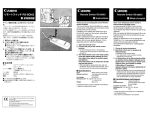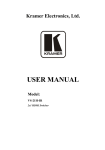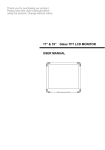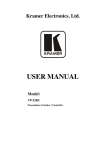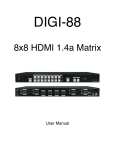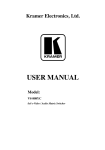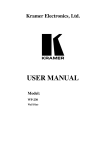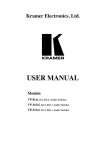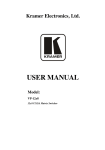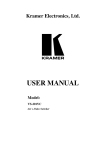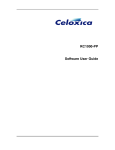Download USER MANUAL
Transcript
Kramer Electronics, Ltd. USER MANUAL Model: RC-1000N Wall Plate Master Controller Contents Contents 1 2 3 4 5 5.1 5.2 5.3 5.4 5.5 6 6.1 6.2 6.3 6.4 6.5 7 7.1 7.2 7.3 8 Introduction Getting Started Overview Your RC-1000N Configuring the RC-1000N Connecting the RC-1000N Controlling via RS-232 (for example, using a PC) Connecting via the RS-485 Terminal Block Connector Assigning Machine Numbers Dipswitch Settings Using the RC-1000N Selecting a Switcher Switching an Input to an Output Disconnecting an Output Locking the Front Panel Routing to a Selected Output (One Touch Mode) Flash Memory Upgrade Downloading from the Internet Connecting the PC to the RS-232 Port Upgrading Firmware Technical Specifications 1 1 2 3 5 5 7 7 8 8 9 9 10 11 11 12 13 13 13 14 18 Figures Figure 1: RC-1000N Front View Figure 2: RC-1000N Rear View Figure 3: Connecting the RC-1000N Figure 4: Connecting the RC1000N to a PC Figure 5: Splash Screen Figure 6: Atmel – Flip Window Figure 7: Device Selection Window Figure 8: Selecting the Device from the Selection Window Figure 9: Loading the Hex Figure 10: RS-232 Window Figure 11: Atmel – Flip Window (Connected) Figure 12: Atmel – Flip Window (Operation Completed) 3 4 6 7 14 14 15 15 16 16 17 18 i Contents Tables Table 1: RC-1000N Features – Front View Table 2: RC-1000N Features – Rear View Table 3: Dipswitch Definitions Table 4: Technical Specifications of the RC-1000N ii 3 4 8 18 KRAMER: SIMPLE CREATIVE TECHNOLOGY Introduction 1 Introduction Welcome to Kramer Electronics (since 1981): a world of unique, creative and affordable solutions to the infinite range of problems that confront the video, audio and presentation professional on a daily basis. In recent years, we have redesigned and upgraded most of our line, making the best even better! Our 350-plus different models now appear in 8 Groups1, which are clearly defined by function. Congratulations on purchasing your RC-1000N, which is ideal for: Presentation applications involving many signal sources Studio control The package includes the following items: RC-1000N Power adapter (12V DC Input) This user manual2 2 Getting Started We recommend that you: Unpack the equipment carefully and save the original box and packaging materials for possible future shipment Review the contents of this user manual Use Kramer high performance high resolution cables3 1 GROUP 1: Distribution Amplifiers; GROUP 2: Video and Audio Switchers, Matrix Switchers and Controllers; GROUP 3: Video, Audio, VGA/XGA Processors; GROUP 4: Interfaces and Sync Processors; GROUP 5: Twisted Pair Interfaces; GROUP 6: Accessories and Rack Adapters; GROUP 7: Scan Converters and Scalers; and GROUP 8: Cables and Connectors 2 Download up-to-date Kramer user manuals from the Internet at this URL: http://www.kramerelectronics.com 3 The complete list of Kramer cables is on our Web site at http://www.kramerelectronics.com 1 Overview 3 Overview The Kramer Wall Plate RC-1000N is a unique two-gang remote control unit designed for broadcast and industrial studio applications. You can use the RC-1000N to configure up to 16 Kramer RS-232 and RS-485 controlled matrix switchers. In particular, the RC-1000N: Lets you connect a PC or other control system via the controller’s RS-232 serial port1 for remote control Has 16 illuminated input/output buttons and a 7-segment display for easy configuration of each switcher Features a TAKE button, to confirm actions Features one-touch-mode operation Has a LOCK button to prevent tampering with the front panel With its FLASH memory, lets you upgrade to the latest Kramer firmware version via Internet download Recalls the previous setup after powering up Can be built into a control table, and is fed from a 12V DC source To achieve the best performance: Connect only good quality connection cables, thus avoiding interference, deterioration in signal quality due to poor matching, and elevated noise levels (often associated with low quality cables) Avoid interference from neighboring electrical appliances and position your RC-1000N away from moisture, excessive sunlight and dust 1 Or via the RS-485 port 2 KRAMER: SIMPLE CREATIVE TECHNOLOGY Your RC-1000N 4 Your RC-1000N Figure 1 and Table 1 define the front view of the RC-1000N: Figure 1: RC-1000N Front View Table 1: RC-1000N Features – Front View 1 2 3 # Feature Holes (4) INPUT / MACH. # 7-segment Display MACH #/TAKE Button 4 5 LOCK Button IN / OUT SELECTOR Buttons Function For fastening the wall plate in place Shows the MACHINE # or the INPUT # or error Determines the functionality of the IN / OUT SELECTOR buttons (from 1 to 16) In the TAKE mode1: press to confirm and complete switching of an input to an output In the MACH # mode2: set the switchers’ machine # Disengages the front panel buttons (see section 6.4) Press to select either the MACH # or the input and output number when switching an input to the output1 (from 1 to 16) 1 In the Take mode (which is the regular operation mode), the MACH #/TAKE button blinks only to confirm a switching action, otherwise it is not lit 2 To enter the Mach # mode, press and hold the MACH #/TAKE button for a few seconds, after which the buttons blinks 3 Your RC-1000N Figure 2: RC-1000N Rear View Table 2: RC-1000N Features – Rear View # 1 2 3 4 5 6 7 4 Feature + 12V DC SUPPLY Setup Dipswitches RS-232 TO PC 3-pin connector RS-232 To SW 1 3-pin connector RS-232 To SW 2 3-pin connector RS-485 Port Function Connect (+) to the connector for powering the unit Connect (-) to the Ground Rear panel setup dipswitches 1 to 4 (see section 5.4) Connects to PC Connects to the RS-232 DB 9 port on a Kramer switcher Connects to the RS-232 DB 9 port on a Kramer switcher Connects to the RS-485 detachable terminal block on a switcher or PC KRAMER: SIMPLE CREATIVE TECHNOLOGY Configuring the RC-1000N 5 Configuring the RC-1000N You can configure the RC-1000N to control up to 16 Kramer switchers. The example in Figure 3 illustrates how to configure the RC-1000N by connecting a: VP-1201 12x1 XGA Switcher / Scanner to the RS-232 TO SW 1 port VP-8x8A 8x8 VGA / UXGA / Audio Matrix Switcher to the RS-485 port of the VP-1201 VP-8x8 VGA / UXGA Matrix Switcher to the RS-485 port of the RC-1000N VP-1608 16x8 RGBHV / Balanced Audio Matrix to the RS-485 port on the VP-8x8 5.1 Connecting the RC-1000N To connect1 the RC-1000N, as illustrated in Figure 3, do the following: 1. Connect a switcher (for example, the VP-1201) to the RS-232 SW 1 port of the RC-1000N. 2. Connect a switcher (for example, the VP-8x8A) via the RS-485 port of the VP-1201 (see section 5.3). 3. Connect a switcher (for example, the VP-8x8) to the RS-485 terminal block connector on the RC-1000N. 4. Connect a switcher (for example, the VP-1608), via the RS-485 port of the VP-8x8 (see section 5.3). 5. Assign a machine number for each switcher (see section 5.4). 6. On the RC-1000N, set the dipswitches as required (see section 5.5). 7. If required, connect the RS-232 TO PC port on the RC-1000N to the RS-232 DB 9 port on the PC or controller. 8. Connect your 12V DC power supply to the 12V DC SUPPLY pins2, taking care that the polarity is correct. 1 Switch OFF the power on each device before connecting it to your RC-1000N. After connecting your RC-1000N, and assigning a machine number for each switcher (see section 5.4), switch on the power on each device 2 Connect the wire labeled “+” to the +12V pin, and the wire labeled “–” to the GND pin 5 Configuring the RC-1000N RC-1000N Rear Panel MACHINE #1 MACHINE #3 VP-1201 VP-8x8 G B A MACHINE #2 RS-232 RS-485 MACHINE #4 VP-8x8A VP-1608 Figure 3: Connecting the RC-1000N 6 KRAMER: SIMPLE CREATIVE TECHNOLOGY Configuring the RC-1000N 5.2 Controlling via RS-232 (for example, using a PC) The RC-1000N is connected to a PC via the RS-232 TO PC port for remote control. When connecting the RC-1000N to a PC you can control all of the switchers functions (such as, audio switching, store and recall, and so on) in addition to performing switching operations. Connect a PC to the RC-1000N unit, as Figure 4 illustrates PIN 5 Connected to Ground PIN 3 Connected to Rx PIN 2 Connected to Tx 1 2 3 4 5 6 7 8 9 Female DB9 (From PC) Figure 4: Connecting the RC1000N to a PC 5.3 Connecting via the RS-485 Terminal Block Connector The RC-1000N can control several switchers, which are connected via the RS-485 terminal block connectors. For example, in Figure 3, the VP-1608 is connected to the RC-1000N via the RS-485 connector of the VP-8x81. To connect additional switchers via RS-485, as illustrated in Figure 3, do the following: 1. Connect the RS-485 terminal block connector of the RC-1000N to the RS-485 port on the VP-8x8 unit, as follows: Connect the “ A” (+) PIN on the RS-485 rear panel port of the RC-1000N to the “ A” (+) PIN on the RS-485 rear panel port of the VP-8x8 unit Connect the “ B” (-) PIN on the RS-485 rear panel port of the RC-1000N to the “ B” (-) PIN on the RS-485 rear panel port of the VP-8x8 unit If shielded twisted pair cable is used, the shield may be connected to the “ GROUND” PIN on one of the units (for example, on the RC-1000N) 2. Connect the RS-485 terminal block port on the VP-8x8 to the RS-485 port on the VP-1608. 1 The VP-8x8A is connected to the RC-1000N via the RS-485 connector of the VP-1201 7 Configuring the RC-1000N 3. Set the RS-485 termination dipswitch ON on the VP-1608 (terminating the RS-485 line at 120 ). 4. Set the RS-485 line termination DIP on the RC-1000N to ON1. You can add up to a total of 16 switchers by cascading them via the RS-485 terminal block connectors on the switchers. 5.4 Assigning Machine Numbers When connecting several switchers to the RC-1000N, each has to be assigned a unique machine number, so the RC-1000N will be able to identify it. For example, in Figure 3 four switchers are connected to the RC-1000N controller, each is assigned a different machine number: The VP-1201 as MACHINE #1 (connected via RS-232) The VP-8x8A as MACHINE #2 The VP-8x8 as MACHINE #3 The VP-1608 as MACHINE #4 You can also set the machine numbers in a different order for your convenience2, except for the machine that is connected via the RS-232, which must be set as MACHINE #1. 5.5 Dipswitch Settings The RC-1000N includes four dipswitches on its rear panel. Table 3 defines the RC-1000N dipswitches: Table 3: Dipswitch Definitions Definition: Function: FLASH PROGRAM ON: for the firmware upgrade procedure (see section 7); OFF: normal operation One Touch Mode ON: set the output once and then switch the selected inputs to that same output; OFF: both OUTPUT and INPUT are selected each time (see section 6.5) N.U. Not used (set to OFF) RS-485 TERM ON: RS-485 termination with 120 (for the first and last machines in the sequence) when a switcher is connected via the RS-485 port; OFF: RS-485 line is open (for other machines) 1 If it is the last unit in the sequence 2 For details of how to set the machine number on each switcher, refer to the relevant Kramer user manual 8 KRAMER: SIMPLE CREATIVE TECHNOLOGY Using the RC-1000N 6 Using the RC-1000N You can use the RC-1000N to operate the switchers in the audio-follow-video (AFV1) mode or the video mode2. Any switching operation performed by the RC-1000N3 will be reflected on the individual switcher’s display, and any switching operation performed by a switcher, will be reflected on the RC-1000N display4 (if that machine is currently selected by the RC-1000N and the same output is selected). To control the configuration illustrated in Figure 3, you can: Select the desired switcher for control (see section 6.1) Select the input to switch to the output (see section 6.2) Disconnect an output (see section 6.3) Lock the front panel (see section 6.4) 6.1 Selecting a Switcher The RC-1000N is usually connected to several switchers. To perform a switching operation on a certain switcher, you have to first select the machine number5 of that switcher6. To select a switcher, do the following: 1. Press the MACH #/TAKE button for a few seconds. The button blinks. 2. Press an IN / OUT SELECTOR button representing the machine # of the switcher you want to control. The number you selected flashes in the 7-segment display. In our example, if you want to control the VP-8x8A switcher7 (as in Figure 3), press button 2. 1 Switching audio and video channels simultaneously 2 If the switcher is in the audio mode, its display will automatically shift to the video mode, and show the video input connections 3 Or PC 4 And PC 5 To set machine numbers, see section 5.4 6 If it is not currently selected 7 VP-8x8A was set to be Mach. # 2 9 Using the RC-1000N 3. Press the MACH #/TAKE button once again. The MACH #/TAKE button blinks a few more times and turns off. RC-1000N now controls the VP-8x8A switcher. Every action taken by the RC-1000N, currently refers to machine #2 (VP-8x8A, as in Figure 3) To control a machine (with a different machine #), just repeat the procedure above, and select the switcher’s machine #. For example, if you want to control the VP-1608 switcher, press the MACH #/TAKE button for a few seconds until it blinks, press IN / OUT SELECTOR button 4, and press the MACH #/TAKE button again. The RC-1000N will now control the VP-1608 machine. 6.2 Switching an Input to an Output In the following example, the RC-1000N controls the VP-8x8A, and input 5 needs to be switched to output 3. To select an input to switch to the output via the RC-1000N, do the following: 1. Make sure the MACH #/TAKE button is not illuminated or blinking. 2. Press an IN / OUT SELECTOR button to select the required output. In this example, press IN / OUT SELECTOR button 3. The SELECTOR button 3 illuminates and the input # which is currently routed to output 3 blinks on the 7-segment display. 3. Press the IN / OUT SELECTOR button to select the required input number. In this example, press IN / OUT SELECTOR button 5. The MACH #/TAKE button blinks and the 7-segment display shows the currently selected input number blinking. 4. Press the MACH #/TAKE button to confirm the action. The selected input number stops blinking on the 7-segment display. In this example, input 5 is now switched to output 3. The SELECTOR button 3 illuminates and the 7-segment display on the VP-8x8A shows that input 5 is switched to output 3. Use the above procedure to continue routing via the RC-1000N. 10 KRAMER: SIMPLE CREATIVE TECHNOLOGY Using the RC-1000N 6.3 Disconnecting an Output You can disconnect an output via the RC-1000N. For example, to disconnect output 3 (which is currently selected1) on the VP-8x8A via the RC-1000N, do the following: 1. Press the IN / OUT SELECTOR button number 3 (which is illuminated) for about 2 seconds. The 7-segment display blinks 0 (zero) and the MACH #/TAKE button also blinks. 2. Press the MACH #/TAKE button. The 7-segment display stops blinking and displays 0 (zero). Output 3 is disconnected. 6.4 Locking the Front Panel To prevent changing the settings accidentally or tampering with the unit via the front panel buttons, lock2 your RC-1000N. Unlocking releases the protection mechanism. To lock the RC-1000N: Press the LOCK button for more than two seconds, until the LOCK button is illuminated The front panel is locked. Pressing a button will have no effect other than causing the LOCK button to blink3 To unlock the RC-1000N: Press the illuminated LOCK button, for more than two seconds, until the LOCK button is no longer illuminated and the front panel unlocks 1 After the action of section 6.2 2 Nevertheless, even though the front panel is locked you can still operate via RS-232 or RS-485 3 Warning that you need to unlock to regain control via the front panel 11 Using the RC-1000N 6.5 Routing to a Selected Output (One Touch Mode) In the One Touch mode, an output is pre-selected and stored for further routing, letting you route an input to that chosen output instantly without having to repeatedly select the same output. To route an input to a stored output in the One Touch mode: 1. Set the ONE TOUCH MODE dipswitch ON. 2. Route an input to the output (see section 6.2). From now on, all inputs will be routed to that output in the One Touch mode. For example, to route to output 1: 1. Set the ONE TOUCH MODE dipswitch ON. 2. Press the IN / OUT SELECTOR button 1 to select output 1. Selector button 1 illuminates and the input, which is currently routed to output 1, blinks on the 7-segment display. 3. Press an IN / OUT SELECTOR button1 to select the input which is to be routed to output 1. From now on, all inputs will be routed to output 1 in the One Touch mode. 4. Press the IN / OUT SELECTOR button 3. Input 3 is instantly routed to output 1. 5. Press the IN / OUT SELECTOR button 2. Input 2 is instantly routed to output 1. 1 Press the currently selected input button if you do not want to change the selection 12 KRAMER: SIMPLE CREATIVE TECHNOLOGY Flash Memory Upgrade 7 Flash Memory Upgrade The RC-1000N firmware is located in FLASH memory, which lets you upgrade to the latest Kramer firmware version in minutes! The process involves: Downloading from the Internet (see section 7.1) Connecting the PC to the RS-232 port (see section 7.2) Upgrading Firmware (see section 7.3) 7.1 Downloading from the Internet You can download the up-to-date file1 from the Internet. To do so: 1. Go to our Web site at http://www.kramerelectronics.com and download the file: “ FLIP_RC1000N.zip” from the Technical Support section. 2. Extract the file: “ FLIP_RC1000N.zip” to a folder (for example, C:\Program Files\Kramer Flash). 3. Create a shortcut on your desktop to the file: “ FLIP.EXE”. 7.2 Connecting the PC to the RS-232 Port Before installing the latest Kramer firmware version on a RC-1000N unit, do the following: 1. Connect the RS-232 TO PC port on the RC-1000N unit to the RS-232 DB9 COM port on your PC (see section 5.2). It is recommended that you use COM port2 2. However, if your computer has only one COM port, open the file: “ RC1000.cfg” (located at C:\Program Files\Kramer Flash\RC1000.cfg) in Notepad, and change “ set port COM2” to “ set port COM1”. 2. Set the FLASH PROGRAM dipswitch to ON 3. Connect your 12V DC power supply to the terminal block connector, taking care that polarity is correct. 1 The files indicated in this section are given as an example only. These file names are liable to change from time to time 2 The software is preset for use with COM port 2 13 Flash Memory Upgrade 7.3 Upgrading Firmware Follow these steps to upgrade the firmware: 1. Double click the desktop icon: “ Shortcut to FLIP.EXE”. The Splash screen appears as follows: Figure 5: Splash Screen 2. After a few seconds, the Splash screen is replaced by the “ Atmel –Flip” window: Figure 6: Atmel – Flip Window 3. 14 Press the keyboard shortcut key F2 (or select the “ Select” command from the Device menu, or press the integrated circuit icon in the upper right corner of the window). The “ Device Selection” window appears: KRAMER: SIMPLE CREATIVE TECHNOLOGY Flash Memory Upgrade Figure 7: Device Selection Window 4. Click the button next to the name of the device and select from the list: AT89C51RD2: AT89C51RD2 T89C51RD2 Figure 8: Selecting the Device from the Selection Window 5. Click OK and select “ Load Hex” from the File menu. 15 Flash Memory Upgrade A Figure 9: Loading the Hex 6. The Open File window opens. Select the correct HEX file that contains the updated version of the firmware for RC-1000N (for example 1000NM_V1p2.hex) and click Open. 7. Press the keyboard shortcut key F3 (or select the “ Communication / RS232” command from the Settings menu, or press the keys: Alt SCR). The “ RS232” window appears. Change the COM port according to the configuration of your computer and select the 9600-baud rate: Figure 10: RS-232 Window 8. 16 Click Connect. In the “ Atmel –Flip” window, in the Operations Flow column, the Run button is active, and the name of the chip appears as the name of the third column: AT89C51RD2. KRAMER: SIMPLE CREATIVE TECHNOLOGY Flash Memory Upgrade Verify that in the Buffer Information column, the “ HEX File: RC-1000N.hex” appears. A RC1000N.hex Figure 11: Atmel – Flip Window (Connected) 9. Click Run. After each stage of the operation is completed, the check-box for that stage becomes colored green1. When the operation is completed, all 4 check-boxes will be colored green and the status bar message: Memory Verify Pass appears2: 1 See also the blue progress indicator on the status bar 2 If an error message: “ Not Finished” shows, click Run again 17 Technical Specifications A RC1000N.hex Figure 12: Atmel – Flip Window (Operation Completed) 10. Close the “ Atmel –Flip” window. 11. Disconnect the power on the RC-1000N. 12. Set the FLASH PROGRAM dipswitch to OFF. 13. Connect the power on the RC-1000N. 8 Technical Specifications Table 4 includes the technical specifications: 1 Table 4: Technical Specifications of the RC-1000N PORTS: POWER SOURCE: DIMENSIONS: WEIGHT: ACCESSORIES: 3 RS-232 ports on terminal block connectors; RS-485 port on a terminal block connector 12 VDC, 100mA Topside: 11.4cm x 11.4cm (4.5” x 4.5”) W, H 0.3 kg (0.67 lbs.) approx. Power supply 1 Specifications are subject to change without notice 18 KRAMER: SIMPLE CREATIVE TECHNOLOGY LIMITED WARRANTY Kramer Electronics (hereafter Kramer) warrants this product free from defects in material and workmanship under the following terms. HOW LONG IS THE WARRANTY Labor and parts are warranted for seven years from the date of the first customer purchase. WHO IS PROTECTED? Only the first purchase customer may enforce this warranty. WHAT IS COVERED AND WHAT IS NOT COVERED Except as below, this warranty covers all defects in material or workmanship in this product. The following are not covered by the warranty: 1. 2. 3. Any product which is not distributed by Kramer, or which is not purchased from an authorized Kramer dealer. If you are uncertain as to whether a dealer is authorized, please contact Kramer at one of the agents listed in the web site www.kramerelectronics.com. Any product, on which the serial number has been defaced, modified or removed. Damage, deterioration or malfunction resulting from: i) Accident, misuse, abuse, neglect, fire, water, lightning or other acts of nature ii) Product modification, or failure to follow instructions supplied with the product iii) Repair or attempted repair by anyone not authorized by Kramer iv) Any shipment of the product (claims must be presented to the carrier) v) Removal or installation of the product vi) Any other cause, which does not relate to a product defect vii) Cartons, equipment enclosures, cables or accessories used in conjunction with the product WHAT WE WILL PAY FOR AND WHAT WE WILL NOT PAY FOR We will pay labor and material expenses for covered items. We will not pay for the following: 1. 2. 3. Removal or installations charges. Costs of initial technical adjustments (set-up), including adjustment of user controls or programming. These costs are the responsibility of the Kramer dealer from whom the product was purchased. Shipping charges. HOW YOU CAN GET WARRANTY SERVICE 1. 2. 3. To obtain service on you product, you must take or ship it prepaid to any authorized Kramer service center. Whenever warranty service is required, the original dated invoice (or a copy) must be presented as proof of warranty coverage, and should be included in any shipment of the product. Please also include in any mailing a contact name, company, address, and a description of the problem(s). For the name of the nearest Kramer authorized service center, consult your authorized dealer. LIMITATION OF IMPLIED WARRANTIES All implied warranties, including warranties of merchantability and fitness for a particular purpose, are limited in duration to the length of this warranty. EXCLUSION OF DAMAGES The liability of Kramer for any effective products is limited to the repair or replacement of the product at our option. Kramer shall not be liable for: 1. 2. Damage to other property caused by defects in this product, damages based upon inconvenience, loss of use of the product, loss of time, commercial loss; or: Any other damages, whether incidental, consequential or otherwise. Some countries may not allow limitations on how long an implied warranty lasts and/or do not allow the exclusion or limitation of incidental or consequential damages, so the above limitations and exclusions may not apply to you. This warranty gives you specific legal rights, and you may also have other rights, which vary from place to place. NOTE: All products returned to Kramer for service must have prior approval. This may be obtained from your dealer. This equipment has been tested to determine compliance with the requirements of: EN-50081: "Electromagnetic compatibility (EMC); generic emission standard. Part 1: Residential, commercial and light industry" EN-50082: "Electromagnetic compatibility (EMC) generic immunity standard. Part 1: Residential, commercial and light industry environment". CFR-47: FCC Rules and Regulations: Part 15: “ Radio frequency devices Subpart B – Unintentional radiators” CAUTION! Servicing the machines can only be done by an authorized Kramer technician. Any user who makes changes or modifications to the unit without the expressed approval of the manufacturer will void user authority to operate the equipment. Use the supplied DC power supply to feed power to the machine. Please use recommended interconnection cables to connect the machine to other components. 19 For the latest information on our products and a list of Kramer distributors, visit our Web site: www.kramerelectronics.com, where updates to this user manual may be found. We welcome your questions, comments and feedback. Safety Warning: Disconnect the unit from the power supply before opening/servicing. Caution Kramer Electronics, Ltd. Web site: www.kramerelectronics.com E-mail: [email protected] P/N: 2900REV 1























